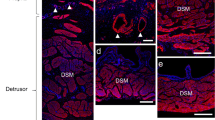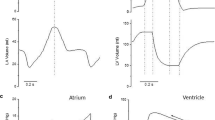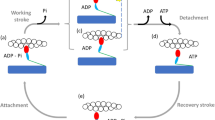Summary
The proportions of fast and slow myosin molecules in external urethral sphincter specimens from ten urodynamically normal male bladder carcinoma patients were estimated from the contents of fast and slow myosin light chains in two-dimensional electrophoretic gels. The percentages of fast and slow myosin molecules ranged from 5.0% to 61.4% with a mean of 35.5% and from 38.6% to 95.0% with a mean of 65.5% respectively. It is therefore concluded that the human external urethral sphincter is composed of both fast and slow muscle fibers as well as other voluntary muscles. The human external urethral sphincter is considered to be a highly fatigue-resistant muscle with a very high proportion of slow muscle fibers. In the cases studied so far, there is a great diversity in the proportions of fast and slow myosin molecules; the reason for this remains unknown.
Similar content being viewed by others
References
Bazeed MA, Thuroff JW, Schmidt RA, Tanagho EA (1982) Histochemical study of urethral striated musculature in the dog. J Urol 128:406
Billeter R, Heizmann CW, Howald H, Jenny R (1981) Analysis of myosin light and heavy chain types in single human skeletal muscle fibers. Eur J Biochem 116:389
Bradford MM (1976) A rapid and sensitive method for the quantitation of microgram quantities of proteins utilizing the principle of protein-dye binding. Anal Biochem 72:248
Fardeau M, Godet-Guillain J, Tome FMS, Carson S, Whalen RG (1978) Congenital neuromuscular disorders: a critical review. In: Aguayo AJ, Karpati G (ed) Current topics in nerve and muscle research. Excerpta Medica, Amsterdam, p 174
Fenner C, Traut RR, Mason DT, Wikman-Coffelt J (1975) Quantification of Coomassie Blue stained proteins in polyacrylamide gels based on analysis of eluted dye. Anal Biochem 63:595
Fitzsimons RB, Hoh JFY (1981) Isomyosins in human type 1 and type 2 skeletal muscle fibres. Biochem J 193:229
Giometti CS, Danon MJ, Anderson NG (1983) Human muscle proteins: analysis by two-dimensional electrophoresis. Neurology 33:1152
Gosling JA, Dixon JS, Cirtchley HOD, Thompson S (1981) A comparative study of the human external sphincter and periurethral levator ani muscle. Br J Urol 53:35
Ishiura S, Takagi A, Nonaka I, Sugita H (1981) Heterogenous expression of myosin light chain 1 in a human slow-twitch muscle fiber. J Biochem 90:279
Johnson MA, Polgar J, Weightman D, Appleton D (1973) Data on the distribution of fiber types in thirty-six human muscles, an autopsy study. J Neurol Sci 18:111
Kelly MA (1983) Emergence of specialization in skeletal muscle. In: Peachey LD, Adrian RH, Geiger SR (ed) Handbook of physiology, sect 10: Skeletal muscle. Williams & Wilkins, Baltimore, p 507
Oelrich TM (1980) The urethral sphincter muscle in the male. Am J Anat 158:229
O'Farrell PH (1975) High resolution two-dimensional electrophoresis of proteins. J Biol Chem 248:4007
Padykula HA, Herman E (1955) Factors affecting the activity of adenosine triphosphatase and other phosphatases as measured by histochemical techniques. J Histochem Cytochem 3:161
Pette D (1980) The plasticity of muscle. de Gruyter, Hawthorne, p 166
Salmons S, Sreter F (1976) Significance of impulse activity in the transformation of skeletal muscle type. Nature 263:30
Sato T, Akatsuka H, Kito K, Tokoro Y, Tauchi H, Kato K (1984) Age changes in size and number of muscle fibers in human minor pectoral muscle. Mech Ageing Dev 28:99
Schantz P, Billeter R, Henriksson J, Jansson E (1982) Traininginduced increase in myofibrillar ATPase intermediate fibers in human skeletal muscle. Muscle Nerve 5:628
Schrøder HD, Reske-Nielsen E (1983) Fiber types in the striated urethral and anal sphincters. Acta Neuropathol 60:278
Tokunaka S, Murakami U, Okamura K, Miyata M, Yachiku S (1986) The fiber type of the rabbits' striated external urethral sphincter: electrophoretic analysis of myosin. J Urol 135:427
Tokunaka S, Murakami U, Fujii H, Okamura K, Miyata M, Hashimoto H, Yachiku S (1987) Coexistence of fast and slow myosin isozymes in human external urethral sphincter. A preliminary report. J Urol 138:659
Weeds A, Trentham D, Kean C, Buller A (1975) Myosin in crossreinnervated cat muscles. Nature 247:135
Author information
Authors and Affiliations
Rights and permissions
About this article
Cite this article
Tokunaka, S., Okamura, K., Fujii, H. et al. The proportions of fiber types in human external urethral sphincter: electrophoretic analysis of myosin. Urol. Res. 18, 341–344 (1990). https://doi.org/10.1007/BF00300784
Accepted:
Issue Date:
DOI: https://doi.org/10.1007/BF00300784




